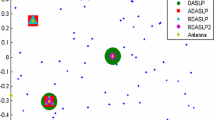Abstract
In this paper, discrete mathematical programming approaches are used to solve the frequency allocation and cell site selection problem in an integrated setup. Both CDMA (code division multiple access) and FD/TDMA (frequency/time division multiple access) technologies will be important for 3rd generation mobile systems. If all users share the same bandwidth, base transmitter stations should be placed such that a maximum of traffic can be carried at low interference rates. The expected traffic is represented by spatially scattered weighted nodes. The problem to select an optimal set of base station locations from a given pool of configurations is formulated as an integer linear program and solved by combinatorial optimization methods. For systems which employ FD/TDMA schemes, the cell site optimization process depends on the assignment of channels. We suggest an integrated linear programming approach to solve both objectives in a single planning step. Because of the problems' tremendous complexity, special branch-and-bound procedures are developed as exact and approximate solution methods. An examples is given for a typical urban scenario with base transmitters below roof tops.
Similar content being viewed by others
References
R. Beutler, Digital single frequency networks: improved optimization strategies by parallel computing, Frequenz 52(5-6) (1998) 90–95.
C. Glaßer, S. Reith and H. Vollmer, The complexity of base station positioning in cellular networks, in: Workshop on Approximation and Randomized Algorithms in Communication Networks (ARACNE) Geneva (2000) pp. 167-177.
S. Fallot-Josselin, Automatic radio network planning in the context of 3rd generation mobile systems, in: Cost 259, Duisburg, Germany (September 1998).
K. Lieska, E. Laitinen and J. Lähteenmäki, Radio coverage optimization with genetic algorithms, in: Proc. of the 9th IEEE International Symposium on Personal Indoor and Mobile Radio Communications, PIMRC '98 (1998) pp. 318-321.
R. Mathar and T. Niessen, Optimum positioning of base stations for cellular radio networks, Wireless Networks 6(4) (2000) 421–428.
A.Monlin, G. Athanasiadou and A. Nix, The automatic location of base stations for optimized cellular coverage: a new combinatorial approach, in: Proceedings Vehicular Technology Conference '99, Houston, Texas (May 1999).
M. Schmeink and R. Mathar, Preprocessed indirect 3D-ray launching for urban microcell field strength prediction, in: Proceedings AP 2000 Millenium Conference on Antennas and Propagation, Davos (April 2000).
K. Tutschku, Interference minimization using automatic design of cellular communication networks, in: Proceedings VTC '98 (Ottawa, 1998).
K. Tutschku, R. Mathar and T. Niessen, Interference minimization in wireless communication systems by optimal cell site selection, in: Proceedings EPMCC '99, Paris (1999) pp. 208-213.
K. Tutschku and P. Tran-Gia, Spatial traffic estimation and characterization for mobile communication network design, J. Select. Areas Comm. 16 (June 1998).
C. Yu, S. Subramanian and N. Jain, CDMA cell site optimization using a set-covering algorithm, in: Proceedings of the 8th International Telecommunication Network Planning Symposium, Sorrento, Italy (October 1998).
Author information
Authors and Affiliations
Rights and permissions
About this article
Cite this article
Mathar, R., Schmeink, M. Optimal Base Station Positioning and Channel Assignment for 3G Mobile Networks by Integer Programming. Annals of Operations Research 107, 225–236 (2001). https://doi.org/10.1023/A:1014959317542
Issue Date:
DOI: https://doi.org/10.1023/A:1014959317542




